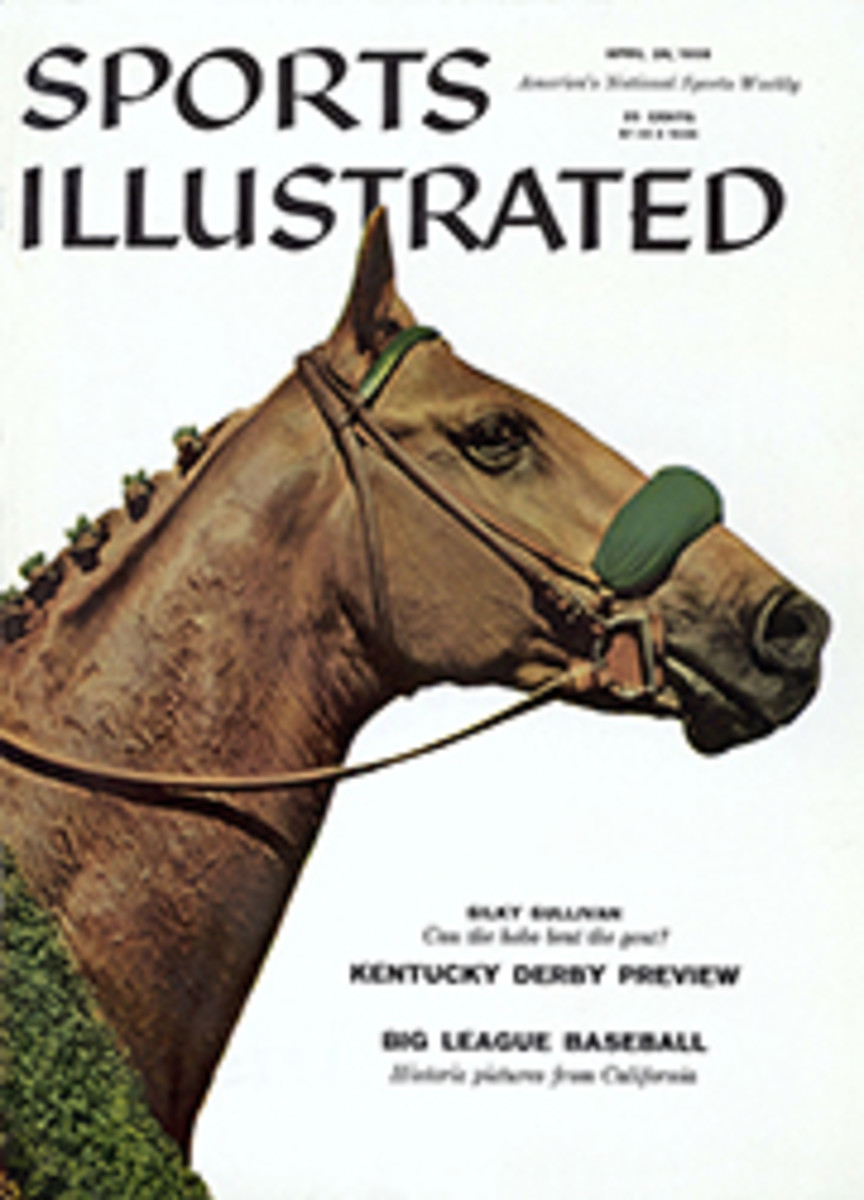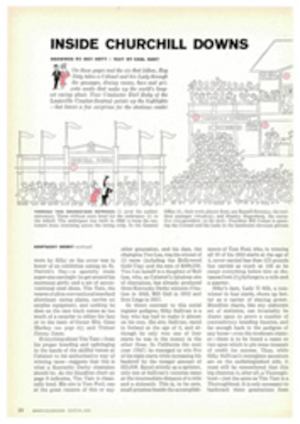
INSIDE CHURCHILL DOWNS
On these pages and the six that follow, Roy Doty takes a Colonel and his Lady through the passages, dining rooms, bars and private nooks that make up the world's longest racing plant. Tour Conductor Earl Ruby of the Louisville Courier-Journal points up the highlights—but leaves a few surprises for the studious reader
Through this grandstand entrance (1) pour the earliest customers. Those without seats head for the underpass (2) to the infield. The underpass was built in 1946 to keep the customers from swarming across the racing strip. In the General Office (3), their work almost done, are Russell Sweeney, the resident manager (standing), and Stanley Hugenberg, the executive vice-president (at the desk). President Bill Corum is greeting the Colonel and his Lady in the handsome six-room private apartment above (4), where later he will entertain the Derby winner and his friends. The elevator (5) to the apartment never is large enough on Derby Day. The boys on the catwalk (6) have chalked up the results of the early races and now await the big one, which also absorbs the customers below (7) at some of the 424 selling windows (there are only 393 cashiers). The Colonel escorts his Lady to a "win" window, much to her alarm. She usually likes to bet three horses to show. This is the historic area where the mellow past mingles with the present, and there is no room for future expansion. The steepled section (shingled roof) is the oldest. It was built in 1895. Prior to that time the stands were on the other side of the track. The paddock (9) and paddock walk (12) separate the grandstand and clubhouse. A tout buttonholes the Lady as the Colonel studies the steeds carrying their potatoes. One clubhouse entrance (8) is at the left. The horses once entered the track through the large opening to the left of the TV truck (extreme right), and the paddock stood where the flower bed now is. It was moved to the left as more and more of the grand-stand was taken over for clubhouse use. Tom Young, track superintendent, has his office on the walkway, almost out on the track itself. A ramp (10) takes clubhouse guests over the heads of grandstand patrons to the Paddock Bar (11). Escalators (13) are numerous, but this is the only one giving direct service to the bourbon mines. Publicist Brownie Leach interviews turf experts in the small TV room (14). And in the Directors' Room (15), Graham Brown, Bill Veeneman and other directors entertain special guests, including the Colonel and his Lady. This is the area of hardest work and gayest play. At the top left is one of the four Film Patrol cameramen (16). Below him (17) are the stewards—Lincoln Plaut, Jack Goode and Lewis Finley. Next on the fourth floor (18) is Room 21, a spot carved out of the eaves in 1946 to accommodate foreign and domestic guests requiring or desiring privacy. It can accommodate 100 persons luxuriously, with a veranda overlooking the track and a private buffet and bar. Below Room 21 is the Derby Lounge (19), built 10 years ago by closing off a section of the veranda and putting doors at each end. Dining Room B (20), immediately below, was the old Circle Bar until 1948. It seats 400 people and is the only dining room from which the track may be seen. The Colonel and his Lady are ensconced in the adjoining Dining Room A, which seats 600. Cameramen (21) line up on the roof. TV Announcers Bryan Field and Fred Capos-sela (22) are next to the photo finish cameraman, Art Kuprion (23), who is exactly over the finish line. Two TV cameramen (25) occupy the highest vantage point at Churchill Downs, the roof above the main part of the press boxes (26), which accommodate 225 workers. Elevator (28) to press box was built in 1951, beside Brownie Leach's publicity office (29) in honor of Buck Weaver, the Louisville Times turf writer who died the year it was built. The placing judges (24), below the photo finish man, are Ray Hoertz, Charles Triplett and Lawrence Lacey. Below the center press box and extending over Dining Room A is a well-secluded nook known as Room 20, or the Matt Winn Room (27). Admission here is gained by special card issued to about 90 carefully selected out-of-city VIPs. There is breathing space as the Colonel and his Lady move down toward the $50 windows at this end of the clubhouse, where the figures are higher and the lines are shorter. This part of the clubhouse extends an eighth of a mile beyond the finish line. It was added in 1936. Downs Bar (30) was blocked off the third-floor promenade in '38. The main clubhouse entrance (31) has been moved several times as the stands have been extended. It isn't likely to move again. There is no place else to go—and the over-all plant already is three-eighths of a mile long. It leads to the clubhouse parking area (32). Latecomers—some Derby fans wait until midafternoon to avoid traffic—hurry through the gates. Here and there a dejected early bird, his hunches all bad, is going home. But not the Colonel and his Lady. They have settled down in a box (below) and will be there until the last hoofbeat echoes from the stables and the setting sun casts its last glimmering glow through the twin steeples.
ILLUSTRATION
ROY DOTY
1
2
3
4
5
6
7
8
9
10
11
12
13
14
15
16
17
18
19
20
21
22
23
24
25
26
26
27
29
28
21
26
26
30
31
32
FIVE ILLUSTRATIONS
ROY DOTY
ILLUSTRATION
ROY DOTY
THE LUCKY COLONEL has a friend who has owned the same box in Section F, third-floor clubhouse (at the finish line), since 1920. There are 3,427 boxes in the clubhouse, and 40,200 seats in the plant. Some 60,000 standees always crowd the infield fences.

